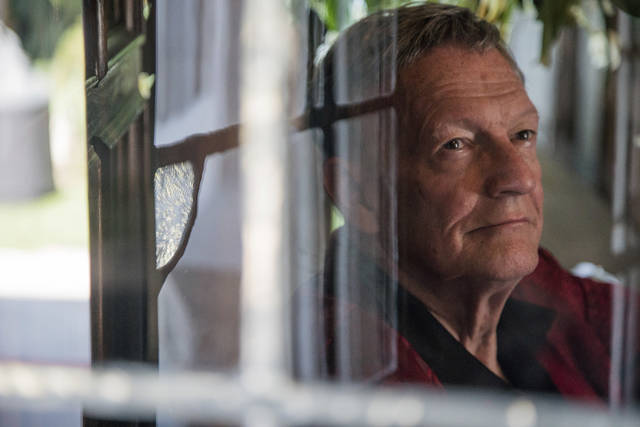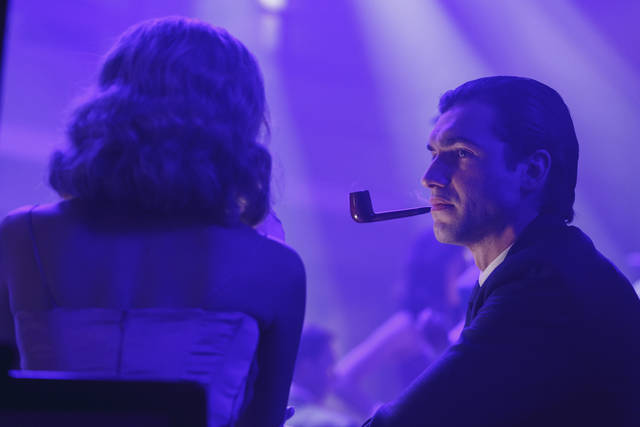NEW YORK — Most Americans would hate living in a world untouched by Hugh Hefner. That’s a message from “American Playboy: The Hugh Hefner Story,” which premieres Friday on Amazon Prime.
NEW YORK — Most Americans would hate living in a world untouched by Hugh Hefner. That’s a message from “American Playboy: The Hugh Hefner Story,” which premieres Friday on Amazon Prime.
It will come as no surprise that this docuseries treats its subject, the founder of the Playboy-magazine-and-beyond empire, with tender, loving care. Co-produced by Playboy Enterprises, its 10 episodes unfold as a hagiography of Hefner, who, back in a dark age of sexual repression, put the “he” in hedonism for countless red-blooded males.
Hefner, who turns 91 on Sunday, played no on-camera role in the series. But he is seen and heard aplenty. Not only are there vast Playboy archives to draw from, but the saga is told mainly through dramatic reenactments, with young lookalike Matt Whelan portraying Hef on-screen and voicing him for the narration.
“My magazine wasn’t just about naked women,” says Hefner/Whelan at the series’ start. “It was about breaking down barriers, starting a cultural conversation about sexuality, and standing up for social justice.”
Mission accomplished. As “American Playboy” is eager to remind its audience, Hefner pushed back against the uptight 1950s with a magazine proclaiming that sex is fun, that it’s OK for guys to like photos of nude women, and that masculinity didn’t correspond directly with hunting and fishing (which men’s magazines of that day dwelled on).
In his new magazine, Hefner meant to champion a lifestyle of masculine creature comforts, a full menu of everything the would-be with-it male would want to feast upon — including the main course of beautiful, seemingly compliant women.
Creating Playboy in his own vision — the vision of whom he yearned to be as a man and manly archetype — Hefner masterminded an intoxicating mix of rebellion, aspiration and pleasure. With his inspired formula, a few thousand borrowed dollars and, as his first Playboy centerfold, a nude calendar photo of pre-celebrity Marilyn Monroe, Hefner launched Playboy in 1953.
It was a smash, and so was he, “the guy who has it all: lavish mansion, legendary parties, and, of course, the women,” says Hefner/Whelan, kicking off the tale (“at least, as I remember it,” he hedges coyly) of how he redefined manhood.
Judging from the three episodes previewed, “American Playboy” airbrushes Hefner’s image as much as Playboy airbrushes its centerfolds. But this doesn’t mitigate Hefner’s role as a game-changer. “American Playboy” shows how his magazine and his example advanced a new Age of Enlightenment — the notion that virility could encompass civil rights and free speech, progressive politics and deep thoughts, as well as sporty cars, the right Scotch and the fine art of seduction. Hefner led a revolution with his pipe, his Pepsis and his legendary rotating bed.
But after a couple of decades, Hef’s revolution was beginning to sputter. A victim of its own spectacular success, Playboy didn’t seem so cutting-edge to youngsters in the late ’60s who claimed free love and doing your own thing as their birthright.
They also claimed women’s rights. The rise of feminism exposed Playboy, for all its advancements, as embarrassingly backward in upholding male privilege. Playboy had always celebrated women. But their designated purpose remained stuck in the past: to please men.
Just consider the Playboy Clubs, which flourished from coast to coast in the 1960s, and not least because of its service staff: the corset-costumed Playboy Bunnies, complete with their rabbit ears and cotton tails. The real stretch for Playboy wasn’t in these skintight outfits. It was how to reconcile Playboy-style panache with the new craze of sit-ins and peace marches.
The Playmate anointed for December 1969 seemed a desperate bid to shed its “Mad Men” brand of hipness and reassert its relevance. To that end, the comely Northwestern University political science major declared on her centerfold questionnaire that “my friends know I’m young, sexy, somewhat intellectual, hate parties, love teachers, enjoy money, clothes, cars” — but also, in a power-to-the-power decree, she made clear that she loved “demonstrations, riots and anything for the revolution.”
The Playboy revolution may have died with that pronouncement. Even so, Playboy presses on to this day. But where it once defied a puritan ideal that kept sex under wraps and condemned nudity as pornographic, now it struggles against a state of oversaturation, where nudity (and almost anything else) runs riot, free of charge, from any video screen.
No wonder little of the Playboy empire remains, at least when judged by the standards it once set. As “American Playboy” shows with cinematic flair, Hefner helped blast the world into a new permissiveness — a world that long ago left him behind.
_____
Online:
https://www.amazon.com


